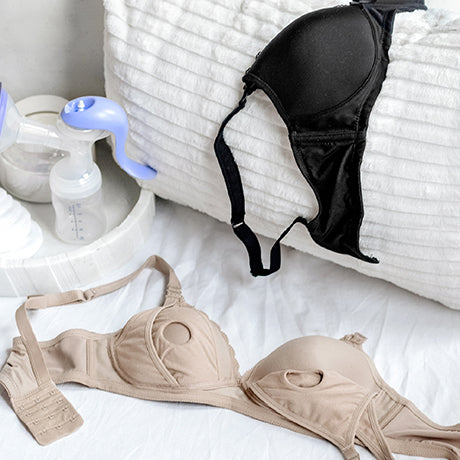Breastfeeding Tips

Congratulations On Your Baby!
Making the decision to breastfeed is an important first step, and breastfeeding is beneficial for both you and your baby.
It’s important to know the facts when making the choice to breastfeed. Share your questions and concerns with your lactation consultant, La Leche League leader, or WIC counselor. Their advice will help you enjoy this special time in your baby’s life.
Benefits of Breastfeeding
Most people are aware that human breast milk provides excellent nutrition for babies. However, breastfeeding also provides many other health benefits for both moms and babies.
Benefits for Mom
- Less bleeding after delivery.
- The uterus returns to its non-pregnant size sooner.
- Less risk of developing breast, ovarian and uterine cancer.
- Burns 200-500 calories a day.
- Promotes a special bond between mom and baby.
- Breastfed babies are healthier, limiting missed days of work and visits to the pediatrician.
Benefits for Baby
- Breast milk is the perfect food for infants because it changes to meet your growing baby’s needs.
- Breast milk is easily digested, resulting in less gas, colic and spitting up.
- Breastfed babies have less respiratory and ear infections.
- Breastfed babies are less likely to develop childhood cancers.
- Breastfed babies have fewer allergies.
Breast Changes
Your breasts start preparing for breastfeeding early in pregnancy. Every healthy woman has the ability to produce breast milk, no matter what her breast size.
- Usually, breasts become somewhat larger during pregnancy.
- The nipple and areola may double in size, darken in color, and become more sensitive.
- By the fifth or sixth month of pregnancy, the breasts may be ready to produce milk. This is why moms of premature infants can breastfeed or express milk for their babies.
- Some women may leak colostrum. Colostrum, which is high in protein, low in fat, and rich in antibodies to help fight infection, is the important first milk for baby.
- Choose a nursing bra toward the end of your last trimester of pregnancy. A good supportive bra is important in determining how you will look and feel.
- Your breasts should return to their normal or near normal size after you stop breastfeeding.
Breast Surgery
If you have had any kind of breast surgery—augmentation, reduction, reconstruction—please let your health care provider know. Many babies can be breastfed after surgery, but close, weekly monitoring of the baby’s weight is recommended.
Latching On

The best way to ensure successful breastfeeding is getting your baby to latch on properly. A baby who latches on well will nurse successfully. If your baby latches on poorly, he will have difficulty getting milk. It may also cause you nipple pain and trauma.
- Sit with a straight, well-supported back.
- Support baby on a pillow, level with the breast.
- Support the breast by lifting it slightly, with your fingers placed flat on the chest wall and your thumb pointing up.
- The nipple should point to baby’s nose toward roof of baby’s mouth. The nipple should extend between the baby’s soft and hard palate.
- Place baby tummy-to-tummy with you.
- Hold baby so his neck can extend slightly as he is moved.
- Touch baby’s top lip to the nipple and move baby away slightly. Repeat until baby opens his mouth wide with tongue forward.
- Move baby quickly onto the breast.
- The baby’s chin should touch the underside of the breast first when latching.
- Baby’s lower lip should be aimed as far from nipple as possible, ensuring the baby’s tongue draws in a sufficient amount of breast tissue.
- Baby’s top lip should be open and curled out and up—bottom lip open and curled out and down.
- It should feel like gentle tugging or suction while baby is sucking—if nipples are sore during nursing, baby should be taken off the breast and repositioned.
Signs of a Good Latch
- You can feel a good suction, without pain.
- You can hear swallowing every couple of sucks. Sometimes the infant will suck for a couple of minutes before you have let-down.
- You can see baby’s jaw and ear moving while sucking.
- You should see pausing between sucks. This means baby is getting mouthfuls of milk.
- You should not feel biting or chomping down while infant is sucking.
- You should not see dimpling of the cheeks.
- You should not be able to hear clicking orsmacking noises.
- Your nipple should appear round when infant comes off breast at end of feeding.
Things to Avoid When Latching
- Chasing the baby with the breast.
- Jiggling the breast up and down.
- Using scissor hold when supporting the breast.
- Pulling baby’s chin down to open his mouth.
- Flexing baby’s neck when bringing baby to breast.
- Bringing breast to baby’s mouth instead of baby to the breast.
Nursing Positions
Correct positioning is important to assure proper latch and comfort for both you and your baby. Holding a newborn and positioning to nurse can feel awkward and overwhelming at first, but with a few helpful tips, the breastfeeding experience will be a rewarding one.
- You should be comfortable, with your back supported, in bed, in a chair, or on a couch, with your trunk facing forward and with a flat lap.
- You may need to experiment with the hold that is most comfortable.
- Baby should be well supported, so you aren't supporting baby’s entire weight during feeding. Even small babies can become heavy after 10 minutes of holding. Several bed pillows or a breastfeeding pillow may be helpful.
- If you are large breasted, a towel roll tucked under the breast against the rib cage can lift the breast enough for the infant to grasp the nipple easier.
Football Hold

This is a good choice for cesarean births, large breasted women, twins or babies having a difficult time latching on.
- Sit upright and place a pillow by your side to support your arm.
- Raise baby to level of the breast.
- Place baby on the pillow on his back, supporting his head and shoulders.
- Baby’s buttocks should be against the back of chair with his legs angled upward.
- Guide baby to the breast by shoulders and head, without bending his back.
- Move baby quickly onto breast.
Cradle Hold

Although this is the most common nursing position, it may not be the best to use in the early days after birth, because baby may not get a deep enough latch.
- Sitting upright, position a pillow on your lap.
- Baby should be placed tummy-to-tummy with you.
- Make sure baby is level to the breast.
- Your hand should support baby’s back and bottom. Baby’s legs should rest on the pillow.
- Hold baby so his neck can extend slightly as he is moved.
- Move baby quickly onto breast.
Cross-Cradle Hold

This is a good position for the early days and weeks when you and your baby are learning, as well as for babies who are having trouble latching.
- Baby’s position is the same as the cradle hold.
- Use the opposite arm to hold the baby.
- Support baby’s neck and shoulders with your hand. Baby’s back is supported by your forearm.
- Your other hand supports the breast.
Side-Lying Position

- Lie comfortably on a bed, sofa or floor.
- Bring baby close and lay him on his side, facing you.
- Lift the breast up with upper hand and stroke baby’s mouth with nipple until he opens his mouth wide.
- Move baby quickly onto the breast.
Tandem Nursing Positions(Nursing two babies at the same time, one on each breast)
The Double Clutch/Football Hold

- Position babies on pillows along each of your sides.
- The babies’ bodies should extend along your sides, under your arms.
The Double Cradle Hold
- Each baby rests the side of his head on your forearm, facing toward the breast.
- The babies’ bodies are crisscrossed in your lap.
- Use pillows to support your elbows.
Cradle and Clutch Hold

- Nurse one baby in the cradle hold while nursing the other in the clutch (football) hold.
- The head of the baby in the clutch hold lines up with the feet of the baby in the cradle hold.
Lying Down
- Lying comfortably on your back, cradle a baby in each arm with their bodies on top of you, knees meeting in the center.
- Use pillows to support your arms.
Milk Composition
Colostrum
- Colostrum is produced from the last weeks of pregnancy to about the 5th day after birth.
- Moms produce about 1 to 3 oz. of colostrum a day for the first few days.
- Babies typically get ½ oz. (Day 1) to 1 ½ oz. (Day 4) of colostrum per feeding. Their tummies are very small at birth and they tend to be a little sleepy, so generally, this quantity is plenty until mom’s milk comes in.
- Colostrum may be yellow or orange in color.
- Colostrum is high in protein, low in fat and rich in antibodies to help fight infection.
Transitional Milk
- Transitional milk is produced from 5 to 15 days after birth, changing in volume and content during that time.
- Sugar, fat, and calories increase in transitional milk over time and protein and antibodies decrease until mature milk levels are reached.
Mature Milk
- Mature milk is produced about 15 days after birth.
- Mature milk may have a yellowish, brownish or blue appearance. Mom’s diet may change the color of the milk.
- Mature milk contains two parts, foremilk and hindmilk:- Foremilk is high in protein, low in fat and calories, and is obtained at the beginning of the feeding.- Hindmilk is the creamy, rich milk the baby will gain weight and grow on.
- Mature milk is unique in that it changes composition according to baby’s needs. For example, a premature infant’s milk is higher in protein and calories.
Let-Down
- Let-down or milk ejection release (MER) happens when baby sucks at the breast.
- Oxytocin, a hormone, causes let-down and squeezes the milk out of the alveoli (sacs), sending the milk through the ducts to the tip of the nipple.
- For several days after birth, oxytocin also causes the uterus to contract. This may feel like menstrual cramping.
- Let-down usually occurs several seconds or minutes into the feeding.
- Some moms describe it as a tingly, prickly sensation, while others don't feel anything at all.
- When let-down occurs, baby will start to swallow more frequently and the sucking pattern will change from short, quick bursts to a longer, slower, rhythmic, suck-swallow pattern.
Supply and Demand
- The amount of milk produced is determined by the amount of milk removed from the breast.
- The more often baby nurses, the more milk you will produce.
- Early and frequent feedings are the key to a good milk supply.
Increasing Milk Supply
- The more frequently you nurse or pump, the more frequently your body will produce milk.
Is Your Baby Getting Enough Milk?
Weight Gain
- Weight gain is the most accurate way to determine if your baby is getting enough milk.
- Most newborns lose at least several ounces in the first couple of days before they start to gain. They are usually back to birth weight by 2 weeks of age.
- Breast-fed babies gain an average of about 4-8 ounces a week in the early months.
Diapers
- After the fifth day of life, baby should have at least 5 or 6 wet diapers. Newborns tend to have several wet diapers a day at first.
- If you have trouble determining if the diapers are wet, place a piece of toilet paper in the front portion of diaper at change. If it is saturated after several hours, you’ll know baby is urinating.
- Baby should have at least 2 bowel movements every day. The early bowel movements will be black and tarry, but, by the 4th day, they should become more yellowish and loose in consistency, maybe even seedy.
Swallowing
- You should hear swallowing every couple of sucks. Sometimes it takes a couple of minutes to hear frequent swallowing before you have let-down. If infant is swallowing infrequently after the first few days of life and is feeding often and for 45-60 minutes at a time, call your lactation consultant or infants health care provider for assistance.
Breast Changes
- Your breasts should feel softer and look smaller after nursing.•It is common to have larger breasts in the first few weeks of nursing. As your milk supply evens out with baby’s demands, breasts may become closer to pre-pregnancy size.
When To Get Help
- If baby goes longer than 10 to 12 hours without nursing.
- If baby has less than 4 wet diapers in a 24-hour period after he is 4 days old.
- If baby goes longer than 24 hours without a bowel movement in the first 4 weeks of life.
- If baby is consistently too sleepy or lethargic to wake and feed after the first couple of days home from the hospital.
- If baby has a fever.
- If you have persistently sore nipples.
Engorgement
Engorgement often occurs around three to five days after birth. The breasts become swollen, hard and painful. The breasts may even look red or pink and shiny. You may have a slightly raised temperature up to 100ºF. Extra nutrients and fluid needed to produce milk are carried through the blood and lymph system and collect in the breast tissue, making them swell.
Helpful Tips
- Frequent, on-demand breastfeeding—at least every 2 hours.
- Apply Ice packs to breasts between feedings—frozen bags of corn or peas work great.
- Raw, green cabbage leaves can be used to relieve swelling. Rinse the leaves well; crinkle them up if they are hard and veiny. Apply to breast, exposing the nipple. Apply for 30 minutes. Place wilted leaves in the refrigerator and repeat again in an hour. Can be repeated several times. Only apply until breast softens—long-term use may decrease milk supply. Do not use if you are allergic to sulfa medications.
- Pump or hand express to comfort between feedings. This may also help the baby to latch on easier.
- If your breasts are leaking, a warm shower may help the milk flow. Heat swells the breast. Do not use heat unless milk is flowing freely from the breast.
Plugged Milk Ducts
Too much milk in the breast may cause a sore spot in the breast that is firm and warm to the touch. A delayed or missed feeding, or a baby that is breastfeeding poorly could be the cause of a plugged milk duct.
Helpful Tips
- Breastfeed often.
- Begin each feeding with the breast that has the plugged duct.
- Apply moist heat to the affected area.•Position infant so his nose is aiming toward the plugged area.
- Put pressure with index and middle finger behind the area that is plugged and apply firm pressure while the infant is sucking for at least several minutes at a time. This helps create a vacuum to release the plug.
- Pump or hand express between feedings to relieve fullness.
- Unresolved milk ducts may result in mastitis.
Breast Infection (Mastitis)
A portion of your breast may be reddened, hot and painful. You may experience chills, fever and/or aches. This condition is called Mastitis. Infrequent, delayed or missed feedings, unresolved engorgement, or bacteria entering a nipple that is cracked or damaged are common causes of Mastitis.
Helpful Tips
- Apply warm moist compresses to affected breast before and during nursing.
- Breastfeed frequently, every 1 to 3 hours during the day, and every 2 to 3 hours at night. The infection will not harm the baby.
- If the breast gets too full between feedings, hand express or pump to soften.
- Drink plenty of fluids and get lots of rest!
- If you develop a fever, call your health care provider.
Sore Nipples
Nipple soreness may happen in the early weeks of breastfeeding. It usually occurs with latch on when the baby draws the nipple and areola into his mouth. If he is not latched correctly, nipple soreness may last the entire feeding and may even cause nipple bruising, blistering or cracking. If baby is latched correctly, soreness should only last a minute. Nipple soreness can also be from a breast engorgement, infection, using a breast pump, or nipple creams.
Helpful Tips
- Position baby correctly on the breast, making sure he is taking in as much nipple and areola as possible.
- You may express colostrum or breast milk onto the nipples after nursing to help heal them.
- Pure lanolin is available over-the-counter to use for sore nipples. You do not need to wipe it off between feedings.
- Changing positions helps put the pressure of baby’s mouth on different areas of the nipple.
- Hydrogel pads can be purchased over the counter and may help in healing.
Thrush
There is a higher risk for developing thrush if you or your baby had a recent course of antibiotics, your nipples are cracked or damaged, or you are taking steroids or oral contraceptives.
Signs of Thrush in the Mother
- Itchy, red, cracked or burning nipples.
- Shooting, intense or deep breast pain during or after feedings that is not alleviated with a better latch or positioning.
- Vaginal yeast infection.
- Mother may have no symptoms.
Signs of Thrush in the Baby
- White patches on the inside of the lips, tongue or cheeks that are not easily washed off.
- Diaper rash.
- Fussiness during nursing or reluctance to nurse because of mouth tenderness.
- Baby may have no symptoms.
Helpful Tips
Thrush can be very difficult to treat. It is important that you talk to your health care provider to determine what treatment is best for you and your baby. There are many treatments for Thrush. Check with your health care provider about these options:
- If you are pumping, be sure to boil all breast pump parts that come in contact with milk for 20 minutes per day. Freezing the milk will not kill the yeast in it. Do not freeze expressed milk during an outbreak.
- Wash anything that goes into your baby’s mouth (toys, bottle nipples, pacifiers) with hot soapy water and boil 20 minutes per day.
- If your baby uses a pacifier or bottle nipple, boil for 20 minutes each day and replace weekly. At the end of treatment, discard all bottle nipples and pacifiers and replace with new ones.•To ease the pain, take ibuprofen every 6 hours (maximum 1200 mg. over 24 hours) until your treatment begins to work.
- You may still breastfeed (or use your expressed milk) throughout the course of your treatment.
Flat or Inverted Nipples
How to tell if you have flat or inverted nipples—the pinch test:
- Place your thumb and index finger at the base of the nipple, or about one inch back, and gently squeeze. Most nipples will protrude.
- Flat nipples will be flat against the dark part of the nipple, not protruding at all.
- Inverted nipples will sink into the breast tissue. This is very uncommon.
Helpful Tips
- Pregnancy hormones sometimes help the nipples protrude, allowing baby to latch on.
- You may need to roll the nipple gently with your fingers before nursing.
- Using a breast pump for a minute or two before nursing helps pull out the nipples.
- Remember, babies need to latch onto some of the breast as well as the nipple. Most babies will latch onto their mother’s breast.
Sleepy Baby
Some babies are sleepy in the first several days or weeks. It is important that you make sure he is getting enough milk.
Helpful Tips
- Watch for signs of wakefulness, lip smacking, rooting, sucking on fists, squirming around or fussing. Offer the breast whenever you see these signs.
- Unwrap baby and place him skin-to-skin with you.
- If baby falls asleep after several minutes of nursing, break the suction and take him off the breast. Rub his back, stroke his face or chest with a cool, wet washcloth, and put him back to the breast.
- If baby is lethargic, nursing infrequently or has a temperature over 100 degrees, call his health care provider.
Nipple Confusion
Babies suck differently at the breast than they do on a bottle. In the early weeks, sometimes even one bottle-feeding can make it hard for baby to latch onto the breast. It is suggested that you wait at least 4 weeks before giving an occasional bottle.
Supplements
- Pediatricians recommend breastfeeding exclusively for the first 6 months.
- It is best to avoid supplementing altogether, especially in the first 4 weeks.
- It takes your body about one month to build a good milk supply.
- The more a baby is supplemented, the less inclined he will be to breastfeed.
- A baby can start solid foods after the first 6 months of life.
- Infants less than 12 months of age should not be given cow's milk.
Helpful Tips
- If you feel you need to supplement, please talk to a lactation consultant, WIC counselor or La Leche League leader.
- If you decide to supplement with something other than breast milk, call your doctor for his suggestion on formula.
Using a Breast Pump
- When you’re away from your baby, you can express milk either by hand, or with a manual, electric, or battery-powered breast pump.
- Consult your lactation consultant, La Leche League leader, or WIC counselor for advice on what type of pump to purchase.
- Using a pump should not be painful for you. If the suction is too intense, you can adjust it.
- When you pump, choose a place that offers privacy.
- To help you express milk, have something with you that reminds you of your baby, such as a picture, the baby’s blanket, or a stuffed toy.
- It may take several attempts to pump before any milk is expressed, and this is perfectly normal.
How to Store Breast Milk
- Use fresh milk over frozen whenever you can.
- Fresh, pumped milk can be stored at room temperature for 6-10 hours. Once breast milk has been refrigerated or frozen and then brought to room temperature, it is good for up to 4 hours.
- Fresh, pumped milk may be refrigerated for up to 8 days.
- Fresh pumped milk can be stored in the average freezer for up to 6 months, depending on the freezing capacity of your refrigerator. If ice cream stays frozen solid, your freezer is adequate for storing milk for 6 months. If ice cream stays soft, your freezer is adequate for storing milk for only 3 months. Milk can be stored in a stand-alone freezer (0º Fahrenheit) for up to 12 months. Store milk in the coldest part of the freezer, away from the door. Milk stored less than 3 months is best.
- Fresh pumped milk that has been refrigerated for up to 48 hours may be frozen. DO NOT FREEZE milk that has been refrigerated for longer than 48 hours.
- Label and date frozen milk, using the oldest first.
- Thaw breast milk in the refrigerator. Never heat breast milk on the stove or in a microwave. Thawed breast milk is good for 4 hours at room temperature, or 24 hours in the refrigerator.
- Do not re-freeze thawed breast milk
Partners
Partners can be a very supportive part of the breastfeeding experience.
- Give the new mother your support as she learns to breastfeed. Take the classes with her.
- Be understanding. It takes a while for mother and baby to adjust to each other, and to breastfeeding. Use encouraging words and actions.
- If possible, take time off to help everyone adjust to the new baby, and the new routine.
- Help with baby care and household chores.
- Stay with mom during feedings. Bring her a drink, a snack, or play her favorite music.
Feeding in Public
You might feel a little awkward or embarrassed the first few times you nurse your baby in public, but with a little bit of skill and patience, and these tips, it will become easier:
- Be alert to your baby‘s hunger cues. Try to find a place to nurse when he first starts to act hungry. It is harder to be discreet if he is crying.
- Find a place that is comfortable: a booth in a restaurant, a bench, changing rooms in department stores.
- Bring your baby close to you and discreetly unfasten your bra. Try lifting your shirt from the bottom to expose less skin.
- Help your baby to latch on, then arrange your clothing or baby’s blanket to cover your skin. Remember, the older the baby gets, the easier he’ll latch on without your help.
- You may want to read a magazine or look into the crowd while you nurse. Chances are most people will not even notice.
- Try nursing in the car before you start your errands or shopping.
Back to Work
Even though it seems difficult at first, continuing to breastfeed after returning to work is worth it. You may miss less work—breastfed babies are sick less often than bottle-fed babies.
- It is best to wait until baby is at least 6 weeks old before going back to work—the longer you can delay your return, the better.
- Wake up early so you will have time to nurse before you leave home.
- Instruct the babysitter to give baby a bottle at least every 3 hours. Breast milk is best.
- Nurse your baby as soon as possible after work and as needed during the night.
- Find a comfortable, clean, and private space for expression and storing breast milk. If a space is not readily available to you, talk to your employer about the benefits of breastfeeding for you and your child. Women who continue to breastfeed after returning to work miss less time because of baby-related illnesses, and have shorter absences when they do miss work, compared with women who do not breastfeed. Working mothers who continue nursing also have higher morale.
- You should have a comfortable place to sit, near an electrical outlet for your pump.
- At work, pump your breasts on breaks and during your lunch hour. Save your milk to give to the baby-sitter the next day. Carry a small cooler, or keep it in the refrigerator at work.
- It’s a good idea to keep extra parts for your pump, in case something gets lost or worn out.
- Keep a supply of nursing pads to help prevent embarrassing leaks. Have an extra nursing bra and blouse on hand to change into in case of a spill or leak.
- Nurse on-demand during the weekend and on days off.
How Long Should I Breastfeed?
You should breastfeed for as long as you feel it is the best thing for you and your baby. This is something only you can decide. Every day that you breastfeed makes a difference in your health and your baby’s. It is suggested that you breastfeed exclusively for 6 months or longer.
Medications and Breastfeeding
- The general rule of thumb is that baby receives 1% of his mom’s medication through her breast milk.
- Many medications are safe to take while breastfeeding. However, some may affect your baby or even your milk supply. Call your doctor, lactation consultant, or pharmacist before taking any medication, even if it is over-the-counter.
- Street drugs of any kind may be dangerous to your baby and should be avoided.
Alcohol and Breastfeeding
- An occasional 1 to 2 drinks (up to 2 oz. of alcohol, 8 oz. of wine, 24 oz. of beer) has not been found to be harmful to the baby. However, alcohol should be avoided.
- Alcohol may decrease milk production if consumed in moderate to large amounts.
- Moderate to heavy alcohol use may also affect how you care for your baby.
Tobacco and Breastfeeding
- Nicotine passes into breast milk in small quantities.
- Quitting smoking is advised for breastfeeding moms. At least cut back as much as possible.
- If you do smoke, try to smoke right after nursing, so the nicotine content is very low by the time the baby nurses again.
- Never smoke around your baby, especially inside the car or house.
Breastfeeding Support
Mothers and babies are all different, as is every situation. We suggest contacting your doctor, nurse, lactation consultant, La Leche League leader, or WIC counselor for expert advice.
Most hospitals offer nursing mother support groups. Talk with your nurse or doctor before you are discharged.
Here are some helpful phone numbers:
- International Lactation Consultants Association (ILCA)
(888) 452-2478 - La Leche League International (LLLI)
(800) 525-3243 - WIC - Women, Infants and Children
Food and Nutrition Service
www.fns.usda.gov/wic





